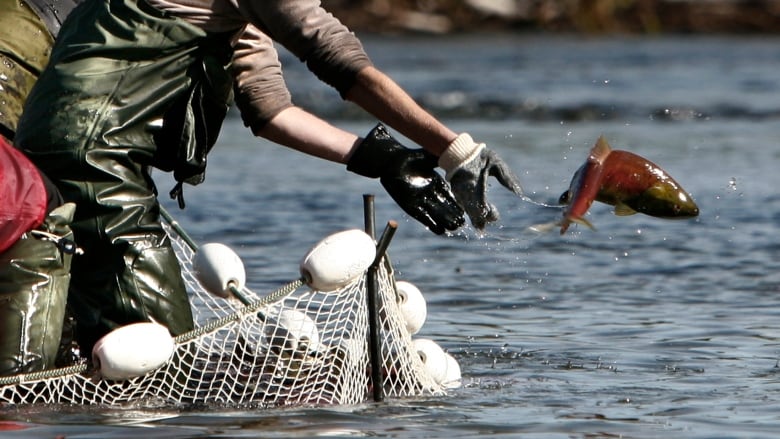Report shows salmon numbers have slowed after B.C. landslide
Summer'srun is the offspring of the sockeye challenged by the 2019 Big Bar landslide

A new reportis providing some early insight on how last month's landslide into the Chilcotin Riveraffected the run of salmon that swims up the Chilcotin and Fraser rivers every year to reproduce.
Monitoring efforts reveal the number ofsalmon that headupstream during August has slowed but the exact scale of the disruption isn'tyet clear.
"The landslide certainly had a role already in slowing the migration," said Scott Hinch, a salmon ecologist at the University of British Columbia. "The issue is whether it's slowed it to the point that these fish are not going to be able to complete their migration up the Chilcotin."
According to anupdate from the Pacific Salmon Commission on Friday, more than 500 sockeye have been spotted upstream of the slide less than one-fifth of the approximately 2,664 sockeye researchers expected to arrive under normal migration conditions at this point in the run.
At the end of July, a landslide blocked the Chilcotin River near Farwell Canyon, about 285 kilometres north of Vancouver. The canyon is a landmark on the salmon's journey to Chilko Lake, where they spawn.
Hinch said the landslide physically obstructed some salmon from passing through. He said the debris that saturated the river afterwards could change how the salmon perceive the water and may hinder their ability to find their way to Chilko Lake.
As the banks of the Chilcotin River are still unstable, Hinch said the sockeye run could encounter more obstacles on their journey upstream.
No sockeye harvest in the Chilcotin River
In its own bulletinFriday, the Tilhqot'in National Government said this summer's run of Chilcotin River chinook and sockeye are at risk of dying out. To help them recover, the nations have issued a one-year pause on fishing the affected runs.
"We're telling people stay away, every last salmon counts at this point,"Chief Joe Alphonse, chair ot theTilhqot'in National Government, told CBC News Tuesday.
That means many members of the nations will have to adapt asthe sockeye salmon run is a significant source of food for Tilhqot'innations.
"We've made some big sacrifices for the protection of our salmon," he said. "That's the most important resource, besides our people, that we have."
Alphonse said his nation is reaching out to nearby fisheries to secure more food for members. He added many members will turnto ice fishingwhen winter arrives.
While the dam has been breached, Alphonse said there are still silt deposits and mounds of debris blocking fish.But as water continues to flow through theChilcotin, it erodesthose barriers.
"Every dayit's carving out more and more of a natural path that these sockeye are accustomed topassing through," Alphonse said.
Jeff Grout, director of salmon management with the Federal Department of Fisheries and Oceans (DFO), said it's still too early to tell how much the slide has affected the run. He said DFO hasinstalled new tools to monitor salmon upstream of the slide.
"At this point, we're not seeing active migration of salmon through the landslide area, but we're also not expecting large numbers to have been there just yet," Grout said Monday.
Grout said while this summer's cohort was one of the more abundant sockeye salmon runs in B.C., DFO expected the run to be smaller than usual. It has not issued any fisheries licences to actively fish for sockeye on the river system this year.
Sockeye salmon runin cycles that repeat approximately every four to five years. Most of this summer'srun is the offspring of sockeyechallenged by the 2019 Big Bar landslide.
While this year's run will face challenges, Hinch said their parents overcame similar difficulties.
"They're actually quite adept at getting through challenging areas and obstacles," he said. "Let's hope that they're able to get through this one."
Researchers expect about 117,000 sockeyeto attempt the run to Chilko Lake this summer.
Grout says the scale of the landslide's effect on salmon will become clearer next weekwhen most of the sockeye are expected to make their way upstream.












_(720p).jpg)


 OFFICIAL HD MUSIC VIDEO.jpg)
.jpg)



























































































